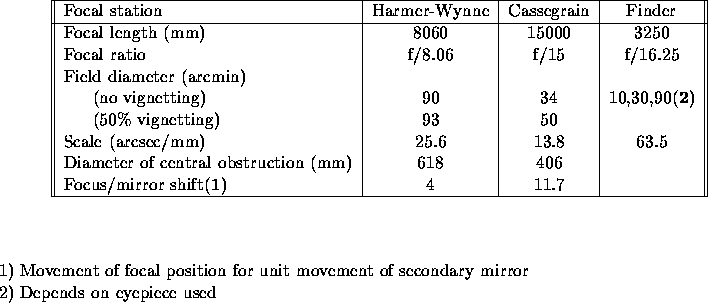 The JKT has two optical configurations:
Harmer-Wynne and Cassegrain. The two optical systems share the same parabolic
primary, with a clear diameter of 1.000 m and a focal length of 4.596 m. It
weighs 215 kg.
Two secondary mirrors are available on interchangeable top ends, as follows:
The JKT has two optical configurations:
Harmer-Wynne and Cassegrain. The two optical systems share the same parabolic
primary, with a clear diameter of 1.000 m and a focal length of 4.596 m. It
weighs 215 kg.
Two secondary mirrors are available on interchangeable top ends, as follows:
(a) a spherical secondary which,
together with the primary mirror and an afocal doublet, constitutes the
f/8.06 Harmer-Wynne system described in Monthly Notices of the Royal
Astronomical Society, 177, 25. This configuration gives
a highly corrected flat focal plane, 90 arcmin in diameter, located 515mm
behind the primary mirror. The angular scale is 25.6 arcsec/mm. This system
gives images smaller than 0.5 arcsec in diameter over the unvignetted field
for incident light wavelengths in the range 3650 Å to 8521 Å.
(b) a hyperbolic secondary constituting,
with the primary, a conventional f/15 Cassegrain system. The curved focal
surface is located 760 mm behind the pole of the primary mirror, giving
a 34.4 arcmin diameter field with a scale of 13.8 arcsec/mm. The total
aberrations on a flat focal surface passing through the nominal focal position
on axis are calculated to be up to about 2 arcsec in diameter over the
unvignetted field. Clearly, the off-axis images can be slightly improved
by focussing the telescope at a compromise
position for the field of view of interest.
The maximum movement of the secondary
mirrors is 20 mm about the nominal focus position. For the f/15 system
this produces a shift of 241 mm about the optimum focal position; the on-axis
image size is calculated to grow approximately linearly with focus shift
up to a maximum diameter of 0.3 arcsec.
Below is a summary of the optical characteristics of the JKT optics (more information can be found at JKT optics (ING Observers' Guide):

 The JKT has two optical configurations:
Harmer-Wynne and Cassegrain. The two optical systems share the same parabolic
primary, with a clear diameter of 1.000 m and a focal length of 4.596 m. It
weighs 215 kg.
Two secondary mirrors are available on interchangeable top ends, as follows:
The JKT has two optical configurations:
Harmer-Wynne and Cassegrain. The two optical systems share the same parabolic
primary, with a clear diameter of 1.000 m and a focal length of 4.596 m. It
weighs 215 kg.
Two secondary mirrors are available on interchangeable top ends, as follows:



